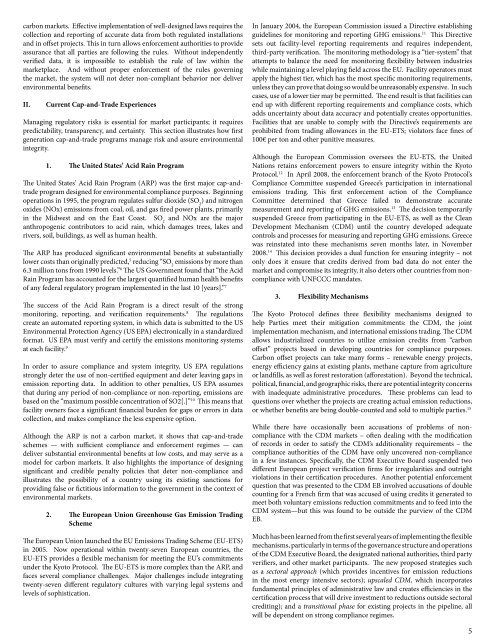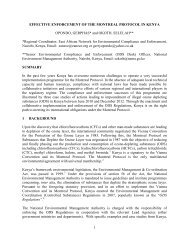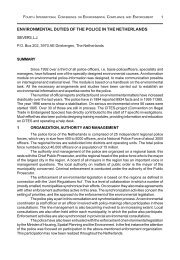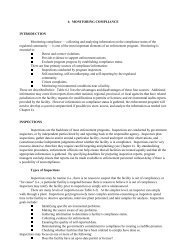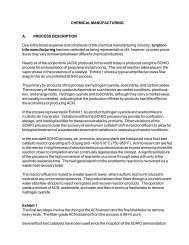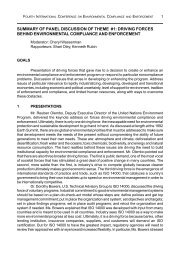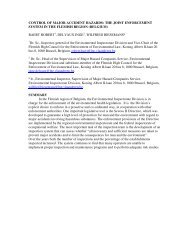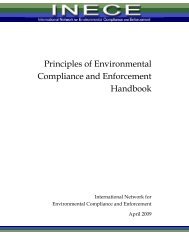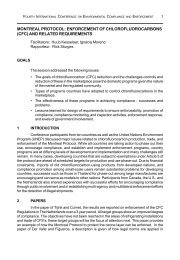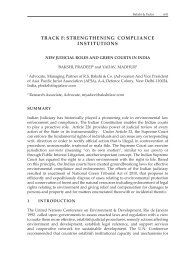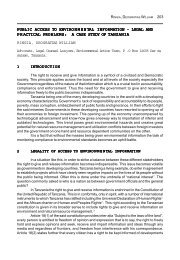Special Report on Climate Compliance - Inece
Special Report on Climate Compliance - Inece
Special Report on Climate Compliance - Inece
- No tags were found...
You also want an ePaper? Increase the reach of your titles
YUMPU automatically turns print PDFs into web optimized ePapers that Google loves.
carb<strong>on</strong> markets. Effective implementati<strong>on</strong> of well-designed laws requires thecollecti<strong>on</strong> and reporting of accurate data from both regulated installati<strong>on</strong>sand in offset projects. This in turn allows enforcement authorities to provideassurance that all parties are following the rules. Without independentlyverified data, it is impossible to establish the rule of law within themarketplace. And without proper enforcement of the rules governingthe market, the system will not deter n<strong>on</strong>-compliant behavior nor deliverenvir<strong>on</strong>mental benefits.II.Current Cap-and-Trade ExperiencesManaging regulatory risks is essential for market participants; it requirespredictability, transparency, and certainty. This secti<strong>on</strong> illustrates how firstgenerati<strong>on</strong> cap-and-trade programs manage risk and assure envir<strong>on</strong>mentalintegrity.1. The United States’ Acid Rain ProgramThe United States’ Acid Rain Program (ARP) was the first major cap-andtradeprogram designed for envir<strong>on</strong>mental compliance purposes. Beginningoperati<strong>on</strong>s in 1995, the program regulates sulfur dioxide (SO 2) and nitrogenoxides (NOx) emissi<strong>on</strong>s from coal, oil, and gas fired power plants, primarilyin the Midwest and <strong>on</strong> the East Coast. SO 2and NOx are the majoranthropogenic c<strong>on</strong>tributors to acid rain, which damages trees, lakes andrivers, soil, buildings, as well as human health.The ARP has produced significant envir<strong>on</strong>mental benefits at substantiallylower costs than originally predicted, 5 reducing “SO 2emissi<strong>on</strong>s by more than6.3 milli<strong>on</strong> t<strong>on</strong>s from 1990 levels.” 6 The US Government found that “the AcidRain Program has accounted for the largest quantified human health benefitsof any federal regulatory program implemented in the last 10 [years].” 7The success of the Acid Rain Program is a direct result of the str<strong>on</strong>gm<strong>on</strong>itoring, reporting, and verificati<strong>on</strong> requirements. 8 The regulati<strong>on</strong>screate an automated reporting system, in which data is submitted to the USEnvir<strong>on</strong>mental Protecti<strong>on</strong> Agency (US EPA) electr<strong>on</strong>ically in a standardizedformat. US EPA must verify and certify the emissi<strong>on</strong>s m<strong>on</strong>itoring systemsat each facility. 9In order to assure compliance and system integrity, US EPA regulati<strong>on</strong>sstr<strong>on</strong>gly deter the use of n<strong>on</strong>-certified equipment and deter leaving gaps inemissi<strong>on</strong> reporting data. In additi<strong>on</strong> to other penalties, US EPA assumesthat during any period of n<strong>on</strong>-compliance or n<strong>on</strong>-reporting, emissi<strong>on</strong>s arebased <strong>on</strong> the “maximum possible c<strong>on</strong>centrati<strong>on</strong> of SO2[.]” 10 This means thatfacility owners face a significant financial burden for gaps or errors in datacollecti<strong>on</strong>, and makes compliance the less expensive opti<strong>on</strong>.Although the ARP is not a carb<strong>on</strong> market, it shows that cap-and-tradeschemes — with sufficient compliance and enforcement regimes — candeliver substantial envir<strong>on</strong>mental benefits at low costs, and may serve as amodel for carb<strong>on</strong> markets. It also highlights the importance of designingsignificant and credible penalty policies that deter n<strong>on</strong>-compliance andillustrates the possibility of a country using its existing sancti<strong>on</strong>s forproviding false or fictitious informati<strong>on</strong> to the government in the c<strong>on</strong>text ofenvir<strong>on</strong>mental markets.2. The European Uni<strong>on</strong> Greenhouse Gas Emissi<strong>on</strong> TradingSchemeThe European Uni<strong>on</strong> launched the EU Emissi<strong>on</strong>s Trading Scheme (EU-ETS)in 2005. Now operati<strong>on</strong>al within twenty-seven European countries, theEU-ETS provides a flexible mechanism for meeting the EU’s commitmentsunder the Kyoto Protocol. The EU-ETS is more complex than the ARP, andfaces several compliance challenges. Major challenges include integratingtwenty-seven different regulatory cultures with varying legal systems andlevels of sophisticati<strong>on</strong>.In January 2004, the European Commissi<strong>on</strong> issued a Directive establishingguidelines for m<strong>on</strong>itoring and reporting GHG emissi<strong>on</strong>s. 11 This Directivesets out facility-level reporting requirements and requires independent,third-party verificati<strong>on</strong>. The m<strong>on</strong>itoring methodology is a “tier-system” thatattempts to balance the need for m<strong>on</strong>itoring flexibility between industrieswhile maintaining a level playing field across the EU. Facility operators mustapply the highest tier, which has the most specific m<strong>on</strong>itoring requirements,unless they can prove that doing so would be unreas<strong>on</strong>ably expensive. In suchcases, use of a lower tier may be permitted. The end result is that facilities canend up with different reporting requirements and compliance costs, whichadds uncertainty about data accuracy and potentially creates opportunities.Facilities that are unable to comply with the Directive’s requirements areprohibited from trading allowances in the EU-ETS; violators face fines of100€ per t<strong>on</strong> and other punitive measures.Although the European Commissi<strong>on</strong> oversees the EU-ETS, the UnitedNati<strong>on</strong>s retains enforcement powers to ensure integrity within the KyotoProtocol. 12 In April 2008, the enforcement branch of the Kyoto Protocol’s<strong>Compliance</strong> Committee suspended Greece’s participati<strong>on</strong> in internati<strong>on</strong>alemissi<strong>on</strong>s trading. This first enforcement acti<strong>on</strong> of the <strong>Compliance</strong>Committee determined that Greece failed to dem<strong>on</strong>strate accuratemeasurement and reporting of GHG emissi<strong>on</strong>s. 13 The decisi<strong>on</strong> temporarilysuspended Greece from participating in the EU-ETS, as well as the CleanDevelopment Mechanism (CDM) until the country developed adequatec<strong>on</strong>trols and processes for measuring and reporting GHG emissi<strong>on</strong>s. Greecewas reinstated into these mechanisms seven m<strong>on</strong>ths later, in November2008. 14 This decisi<strong>on</strong> provides a dual functi<strong>on</strong> for ensuring integrity – not<strong>on</strong>ly does it ensure that credits derived from bad data do not enter themarket and compromise its integrity, it also deters other countries from n<strong>on</strong>compliancewith UNFCCC mandates.3. Flexibility MechanismsThe Kyoto Protocol defines three flexibility mechanisms designed tohelp Parties meet their mitigati<strong>on</strong> commitments: the CDM, the jointimplementati<strong>on</strong> mechanism, and internati<strong>on</strong>al emissi<strong>on</strong>s trading. The CDMallows industrialized countries to utilize emissi<strong>on</strong> credits from “carb<strong>on</strong>offset” projects based in developing countries for compliance purposes.Carb<strong>on</strong> offset projects can take many forms – renewable energy projects,energy efficiency gains at existing plants, methane capture from agricultureor landfills, as well as forest restorati<strong>on</strong> (afforestati<strong>on</strong>). Bey<strong>on</strong>d the technical,political, financial, and geographic risks, there are potential integrity c<strong>on</strong>cernswith inadequate administrative procedures. These problems can lead toquesti<strong>on</strong>s over whether the projects are creating actual emissi<strong>on</strong> reducti<strong>on</strong>s,or whether benefits are being double-counted and sold to multiple parties. 15While there have occasi<strong>on</strong>ally been accusati<strong>on</strong>s of problems of n<strong>on</strong>compliancewith the CDM markets – often dealing with the modificati<strong>on</strong>of records in order to satisfy the CDM’s additi<strong>on</strong>ality requirements – thecompliance authorities of the CDM have <strong>on</strong>ly uncovered n<strong>on</strong>-compliancein a few instances. Specifically, the CDM Executive Board suspended twodifferent European project verificati<strong>on</strong> firms for irregularities and outrightviolati<strong>on</strong>s in their certificati<strong>on</strong> procedures. Another potential enforcementquesti<strong>on</strong> that was presented to the CDM EB involved accusati<strong>on</strong>s of doublecounting for a French firm that was accused of using credits it generated tomeet both voluntary emissi<strong>on</strong>s reducti<strong>on</strong> commitments and to feed into theCDM system—but this was found to be outside the purview of the CDMEB.Much has been learned from the first several years of implementing the flexiblemechanisms, particularly in terms of the governance structure and operati<strong>on</strong>sof the CDM Executive Board, the designated nati<strong>on</strong>al authorities, third partyverifiers, and other market participants. The new proposed strategies suchas a sectoral approach (which provides incentives for emissi<strong>on</strong> reducti<strong>on</strong>sin the most energy intensive sectors); upscaled CDM, which incorporatesfundamental principles of administrative law and creates efficiencies in thecertificati<strong>on</strong> process that will drive investment to reducti<strong>on</strong>s outside sectoralcrediting); and a transiti<strong>on</strong>al phase for existing projects in the pipeline, allwill be dependent <strong>on</strong> str<strong>on</strong>g compliance regimes.—5


